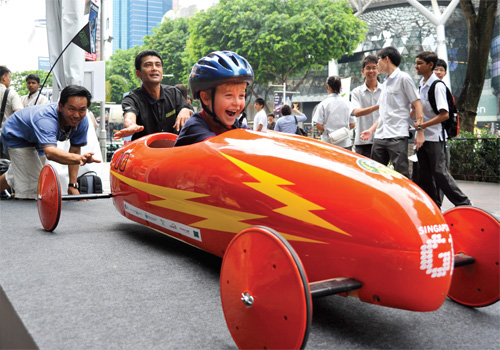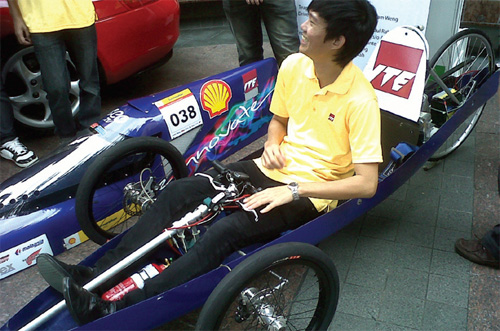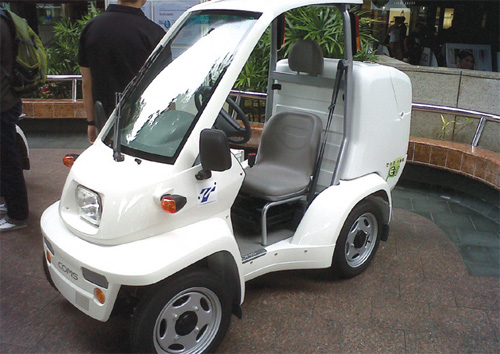The inaugural Singapore G1 shows that you can save the environment while getting your dose of wheel action on the tracks.
Contributed By Jeremy Chua
 Arriving from Cluny Road amidst a flurry of discharging camera flashbulbs and appreciative “oohs” and “aahs” from the crowd, the electric-motor driven BMW and Porsché were almost phantom-like in their arrival, without the usual combustion-engine growl. Having been retrofitted with electric motors, the cars were part of the attraction at the launch of the Singapore Green One, otherwise known as G1, on Sep. 4 at the Shaw House Amphitheatre. The launch was hosted by active green advocate and media personality Nadya Hutagalung and graced by Guest-Of-Honor Dr. Teo Ho Pin, Mayor of North West District and Member of Parliament for the Bukit Panjang Constituency.
Arriving from Cluny Road amidst a flurry of discharging camera flashbulbs and appreciative “oohs” and “aahs” from the crowd, the electric-motor driven BMW and Porsché were almost phantom-like in their arrival, without the usual combustion-engine growl. Having been retrofitted with electric motors, the cars were part of the attraction at the launch of the Singapore Green One, otherwise known as G1, on Sep. 4 at the Shaw House Amphitheatre. The launch was hosted by active green advocate and media personality Nadya Hutagalung and graced by Guest-Of-Honor Dr. Teo Ho Pin, Mayor of North West District and Member of Parliament for the Bukit Panjang Constituency.
Organized by the Singapore Environment Council, the G1 race, which will be held a week before the Formula One on Sep. 19 at the Float@Marina Bay, aims to raise awareness of environmentally-friendly transport technologies and habits. It will feature races like the famed Soap Box Derby, Eco Car Race, Buggy Race, Trishaw Race and also a walk and cycle event which will start from all over the island and culminate at the Float@Marina Bay.
 Speaking on the commercial viability of greener energy options, David Chou, Managing Director of EV Hub, an electrical vehicle integrator company which retrofitted the afore-mentioned Porsché and BMW, says, “They suffer from minimal performance decline as you get better acceleration as an electric motor is 90 percent efficient, compared to the 30 percent efficiency of a combustion engine. It is also more cost effective, with each trip costing you three to five times less than what petrol would cost. The maintenance is cheaper as well.”
Speaking on the commercial viability of greener energy options, David Chou, Managing Director of EV Hub, an electrical vehicle integrator company which retrofitted the afore-mentioned Porsché and BMW, says, “They suffer from minimal performance decline as you get better acceleration as an electric motor is 90 percent efficient, compared to the 30 percent efficiency of a combustion engine. It is also more cost effective, with each trip costing you three to five times less than what petrol would cost. The maintenance is cheaper as well.”
Besides being the first “Green Grand Prix,” the G1 will also usher in the first-ever Soap Box Derby to be held in Asia, where 30 local schools will have the chance to race the soap-box cars that they designed and assembled.
City News rounds up the lean and green vehicles that will be hitting the tracks on Sep. 19 at the Float@Marina Bay from 2 p.m.
THE ASIAN DEBUTANTS
Making its debut in Asia is the Soap Box Derby, which has garnered something of a cult following in countries including the U.S.A., England, and Australia. Traditionally, the soap box cars are made of what gave them their name: wooden soap boxes. Nowadays, however, soap-box cars are very sophisticated, as evident from the two cars unveiled at the G1 launch. Sleek, aerodynamic lines, and cutting edge fibreglass materials have made this sport faster and safer, not to mention more pleasing to the eye—somewhat like a kayak on wheels. Running on gravity, the soap-box cars, which consist of simple steering and brakes, can hit speeds in excess of 50 km/hr, with no motor at all. The spotlight of the G1 will firmly be on these flashy carts as they zoom down part of the designated F1 track.
 THE FRANKENSTEIN PETROL SIPPER
THE FRANKENSTEIN PETROL SIPPER
Imagine crossing Singapore end to end three times, with less than the equivalent of three soft-drink cans of petrol. That is how much petrol the ITE Eco XV would sip at its peak performance.
Resembling a futuristic space pod, and driven like a street luge, with the driver lying down on his back, feet first, the Eco XV is designed and built by the students from ITE College West. The eco-car has taken part in many green competitions, the latest being the Shell Eco-Marathon, at the Sepang racing circuit in Malaysia in July. Lu Yao Hao, 22, the team’s driver revealed that everything was built from scratch other than the fibreglass shell, sponsored by Shell. What makes the Eco XV impressive is that it can reach a top speed of 40km/hr despite being made up of a Frankenstein mix of mountain bicycle parts and propelled by nothing more than a grass-cutter motor.
It will be one of the cars racing down the F1 track at the Float@Marina Bay, competing against other cars powered by conventional petrol, bio-fuels, solar or hydrogen cells—all designed by students from 10 local tertiary institutions.
 |
| PHOTO COURTESY OF SINGAPORE ENVIRONMENT COUNCIL |
THE CUTE ELECTRIC BUGGY
Already running on the roads of Japan, the adorable looks of the COMS electric buggy, developed by Toyota Tsusho belies its capabilities. Looking like a quad-bike’s cuter cousin, this buggy can hit a top speed of 60km/hr. Running on what is dubbed as the “Wheel Inn Motor” system, where the rear wheels are driven by its own dedicated motor, it is definitely a viable source of personal transport in Singapore. Jimmy Tan, business manager of Toyota Tsusho, shares, “This is a great green option, especially for delivery services. It is more environmental friendly and safer than your average motorcycle.” The COMS electric buggy can be easily charged via a household electrical outlet, and talks with the Land Transport Authority are underway to introduce the COMS electric buggy to Singapore roads.
Various corporate teams will be competing against each other on an obstacle course in the Buggy Race.
The four-hour Singapore G1 will take place at the F1 track on Sep. 19. Log on to www.singaporeg1.sg for detailed schedule of races.
